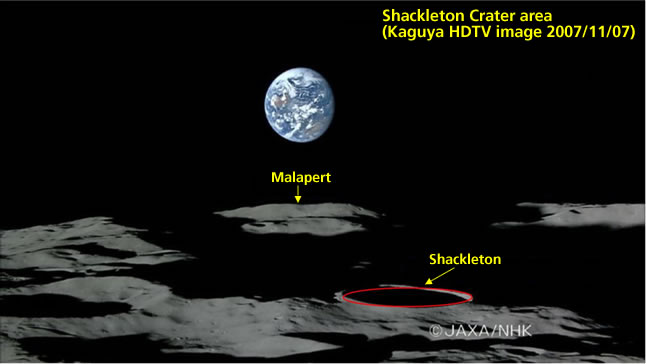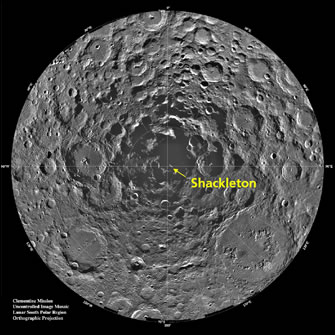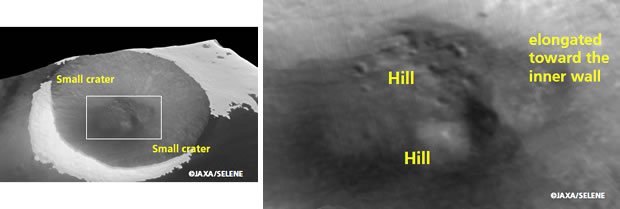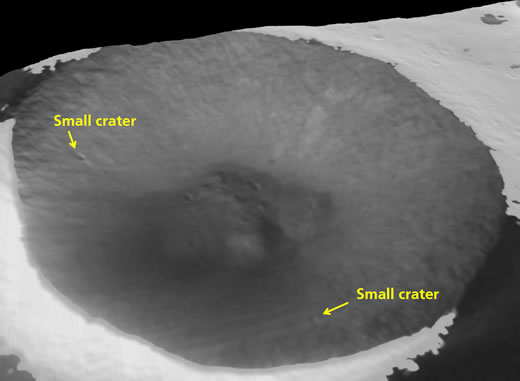Lack of Exposed Ice Inside Lunar South Pole Shackleton Crater published in Science Express of Science Magazine
Japan Aerospace Exploration Agency (JAXA)
A new result from the Terrain Camera (TC) observation data onboard the Japanese lunar explorer "KAGUYA (SELENE)" was published in Science Express, the electronic publication of selected Science papers in advance of the print edition of Science magazine, on October 23, 2008. The TC team*1 reported that the TC succeeded in three dimensional imaging of the Shackleton Crater on the lunar south pole. The inside of the crater is permanently shadowed and is believed to hold water-ice deposits. However, the derived albedo indicates that exposed relatively pure water-ice deposits are lacking on the floor of the TC’s spatial resolution.
The TC team will search for the existence of water-ice inside other craters in the polar regions, which are permanently shadowed, by using the same method.
*1 Principal Investigator of TC camera ISAS/JAXA Junichi Haruyama

Figure 1 HDTV image of the south pole near the Shackleton Crater

Figure 2 Clementine mosaic image with the location of the Shackleton Crater
The Shackleton Crater, with a diameter of 21 km, is located near the south pole and its inside is permanently shadowed. The permanently shadowed area inside of the Shackleton Crater is cold enough to hold water-ice. Bi-static radar observations by the Clementine (launched in 1994) suggested that water-ice deposits existed inside the Shackleton Crater. However, subsequent Earth-based radar observations showed little evidence of the existence of water-ice deposits, although they could observe only an upper part of the inner wall of the Shackleton Crater. The Neutron spectrometer onboard the Lunar Prospector (launched in 1998) showed the possibility of the existence of highly-concentrated hydrogen in the south pole region including the Shackleton Crater, but it was unknown that the possible hydrogen was from water-ice.
In contrast, a new result from the Terrain Camera (TC) observation data onboard the Japanese lunar explorer "KAGUYA (SELENE)" shows that exposed relatively pure water-ice deposits are lacking in the permanently shadowed area inside the Shackleton Crater. The estimated temperature of the crater floor based on the crater shape model derived from the TC data is < ~ 90K, cold enough to hold water-ice. However, the derived albedo indicates that exposed relatively pure water-ice deposits are lacking on the floor of the TC's spatial resolution. Water-ice may be disseminated and mixed with soil in some areas, or may not exist at all. This result is consistent with the estimated amount of water-ice by the Lunar Prospector.

Figure 3 TC image by the Shackleton Crater (Observation: November 19, 2007)
Right: A brightness-enhanced image of the left image.
The TC team also successfully developed a three dimensional image inside the Shackleton Crater for the first time by using TC observation data. The Shackleton Crater is a truncated cone-shaped crater with almost a concentric circular rim with a radius of up to 10.5 km and a floor with a radius of about 3.3 km, and a depth of about 4.2km; it is much deeper than other similar-sized lunar craters. Inside, the crater had an almost smooth but cratered inner wall. Two mounds are seen adjacent to the inner wall, which are probably landslides from the inner wall. A hill a few hundred meters high occupies the crater center. A terrace structure is associated with the hill and elongated toward the inner wall. It has a number of depressions that are probably craters.


Figure 4 A three dimensional image of the Shackleton Crater
Lower: An enlarged image of inside of the Shackleton Crater
The entire rim of the Shackleton Crater is tilted about 1.5 degrees toward 50-90 degrees from the Earth-side. Thus, under illumination conditions in the lunar summer, the solar elevation angle from the opposite-side rim occasionally becomes up to 3.0 degrees, On a few days when the sub-solar point is below 70°E in longitude and less than 1.5°S in latitude, like on 19 November, 2007; we could obtain images of the inside of the Shackleton Crater on rare occasions during the SELENE initial check out period.

Figure 5 Shackleton Crater Feature
|
|